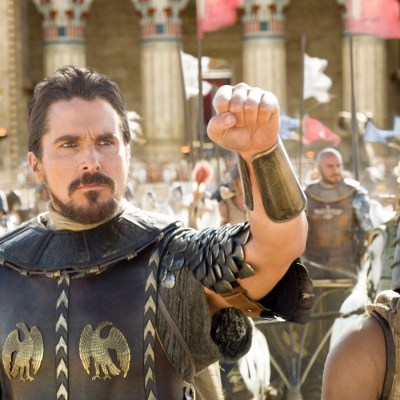Cleopatra and the First Time 20th Century Fox Almost Died
We look back at Cleopatra, the most notorious production in Hollywood history. Are there still lessons today in the film that almost killed 20th Century Fox the first time?
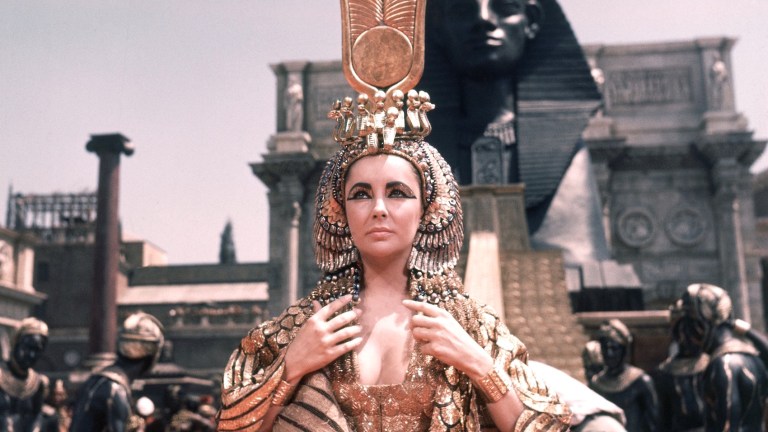
Spyros Skouras was a practical man with a dream. As a finance-minded studio executive who made his bones in the industry as a frugal theater owner during the Depression, Skouras was looking for a safe bet when he asked producer Walter Wanger to remake the story of Cleopatra on a budget of $2 million. It didn’t work out that way.
Nearly 60 years after Elizabeth Taylor rode into Rome on a sphinx, the gaudy, extravagant, and moribund epic that is Hollywood’s most iconic Cleopatra remains the stuff of legend—and perhaps hellish nightmares for studio execs with greenlighting powers. What was intended to be a by-the-numbers remake of a 1917 film, shot at cost on Fox’s already vanishing backlot, instead became the most expensive international production of its age: a movie with two Alexandrias, two directors, two Antonys and two Caesars, and one highly demanding Cleopatra. Indeed, Taylor was the first woman to command $1 million for her acting salary, which she might say was the fondest memory from the whole ordeal.
Despite being the highest grossing movie of 1963, and a pop culture touchstone that no less than Andy Warhol called the most influential movie of the ‘60s, Cleopatra was a long way from the movie anyone involved wanted, especially Fox bean counters. While the film eventually squeezed out a small profit years later in rerelease, the film’s final cost of $44 million—about $369 million in 2020 dollars—nearly bankrupted the studio, shut down production across the Fox lot, and ended the careers of Skouras and Wagner alike. And its tale of disaster is still a timely one, especially today with Fox finally dead and studios still inching their ways toward $350 million budgets becoming a norm…
A Dream of Egypt
The truth is long before Fox approached him, producer Walter Wanger had a love for the myth, if not the actual history, of Cleopatra. A dapper character who imagined himself as something of an old school gentleman, maybe it was the hopeless romantic in Wanger that attracted him to the idea of an Egyptian Queen who turned two of the most powerful men of her age into lovers and confidants in world conquest? Or maybe he could just relate to stories of sordid trysts and betrayals because he served four months in prison after discovering his wife, movie star Joan Bennett, was having an affair with her agent, and then literally shot the other man in the balls. Who knows?
The point is he loved the idea of Cleopatra, Queen of the Nile, and wanted to tell her story throughout the 1950s. After he spent that decade largely rebuilding his career post-prison with memorable B-movies like Invasion of the Body Snatchers (1956), opportunity arrived on the Fox lot. There he was pounced on by Skouras and Fox executive David Brown. It’d been Brown who was ordered by Skouras to raid the vault for old intellectual property that could be repurposed, and it was Brown who was taken by the idea of remaking the original Fox Film Corporation’s Cleopatra (1917), which starred Theda Bara. He was also probably thinking about Paramount’s early talkie Cleopatra (1934), a big hit for star Claudette Colbert and director Cecil B. DeMille’s last lustful pre-Code film.
Wanger wanted to make Cleopatra, but he didn’t want to make the film Skouras was imagining. A Greek immigrant and the son of literal sheepherders, Skouras saw no reason why backlots wouldn’t do, or why Wanger shouldn’t use one of their contract players to portray the last monarch of Egypt. They even screen tested Fox starlet Joan Collins in the role. And yet, by producing concept art out of his own pocket that depicted a lavish epic more in line with recent blockbuster Ben-Hur (1959), Wanger convinced Fox this wasn’t a run of the mill swords and sandals drama: it would be a cinema classic for the ages! He got the budget pushed to $5 million and was granted permission to begin searching for a marquee movie star name to play the title role. It was all downhill from there.
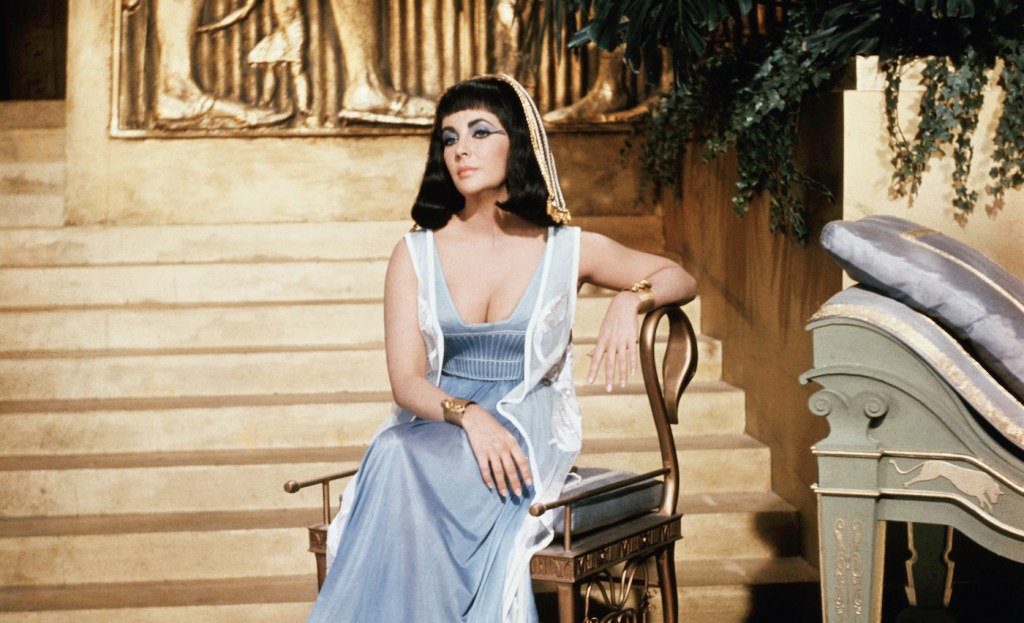
A Crown Worthy of a Million Bucks
Fox executives bandied around a lot of names for Cleopatra, from Susan Hayward to Italian bombshell Sophia Loren. For his part, Skouras favored Audrey Hepburn. But Wagner only wanted the violet-eyed Elizabeth Taylor.
Arguably the biggest movie star of the early ‘60s, Taylor had grown up in front of the public from sweet tomboy next door in National Velvet (1944) to sex symbol with a long line of scandals, box office hits, and husbands trailing in her wake. By 1960, she’d already been married three times, with her third ex dying tragically in a plane crash. Yet the public sympathy she gained from this despair was short-lived after she grieved on the shoulder of lounge act Eddie Fisher—who soon became her fourth husband despite being married to America’s sweetheart Debbie Reynolds (and father of future Princess Leia Carrie Fisher).
All of these headline-generating liaisons tended to obscure the promise Taylor featured as an actor at the time—I would argue it obscured it her whole life with misbegotten vanities like Cleopatra dashing the chance of building on the talent teased in George Stevens’ Giant (1956) and Cat on a Hot Tin Roof (1958). Either way, with a voluptuous frame and indifference to bad publicity, Taylor was the new idol of her age and Wanger’s top (miscast) choice for Cleopatra. The only problem was she thought the idea of playing an Egyptian Queen of Greek descent was faintly ludicrous. When Wanger pitched it over the phone, Taylor alleged she laughed and passed the phone off to Eddie. “Tell him I’ll do it for a million dollars,” Taylor allegedly japed to husband #4. He relayed the message and Wanger agreed.
At the time, only one movie star had commanded $1 million per picture—Marlon Brando for the Mutiny on the Bounty remake—and Wanger had no clearances from Fox to offer what was intended to be a fifth of the movie’s budget. In fact, there was a small revolt with Skouras trying to undo the agreement. But when he polled his beloved theater owners over who they’d rather see as Cleopatra, Elizabeth Taylor or Audrey Hepburn, they all said give us Liz! (Perhaps for this reason, Hepburn was adamant about not letting Taylor get the role of Eliza Doolittle in My Fair Lady a few years later.)
In addition to commanding $1 million, Taylor also demanded the film be shot internationally to make it a true epic, and filmed on 70mm Todd-AO, an invention that late husband Mike Todd created to compete with CinemaScope, and which Taylor just happened to now own. These drip-drops of surprise expenses were about to become a waterfall.
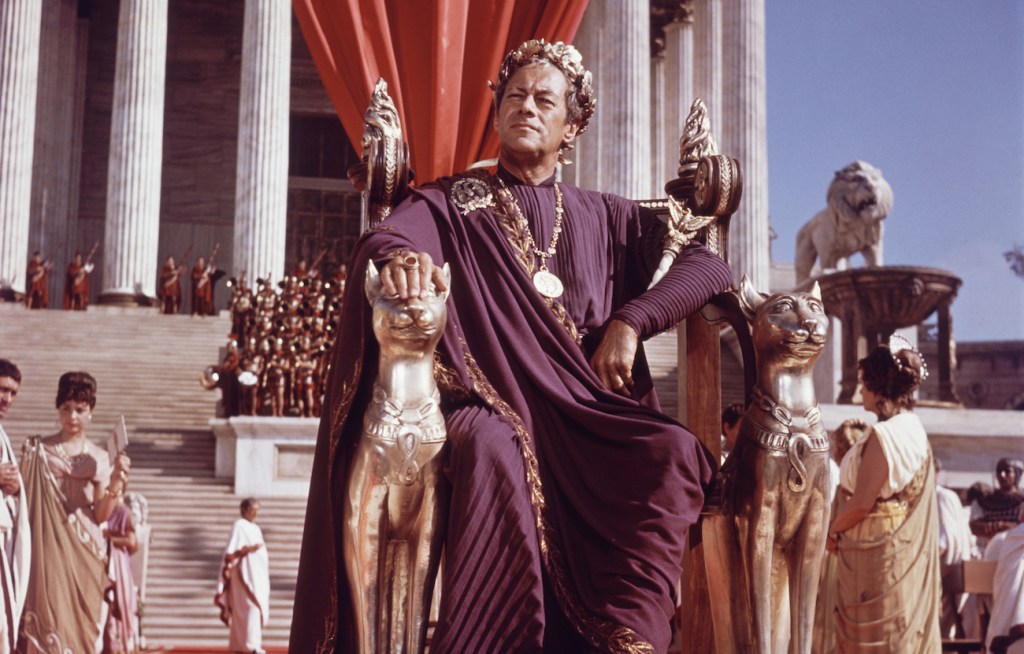
The Nile By Way of London
To helm the picture, Wanger picked Rouben Mamoulian, who’d enjoyed some success directing star vehicles in the ‘30s for Greta Garbo. He also directed arguably the best Dr. Jekyll and Mr. Hyde movie in ’31 and 1940’s The Mark of Zorro. An old school pro, he was expected to handle Taylor’s glamour shots and keep the production moving smoothly.
Of course there was the small pickle of where that production should be. Despite location scouting in Italy and Turkey, Fox decided (against Mamoulian’s objections) that the studio would save money if Cleopatra filmed outside of London at the famed Pinewood Studios. At an expense of $600,000, the local craftsmen turned all 20 acres of their exterior backlots into ancient Alexandria. But the funny thing about England is how even in the warmest summer months, it totally does not resemble Southern Italy or Mediterranean Egypt. And Fox attempted to begin production on Cleopatra in the winter of 1960/61.
While Pinewood ran local ads throughout the UK begging for more construction workers to join the adventure, it turned out to rain a lot in London (shocker), and the vast “marble” sets made of papier-mâché began peeling on a near daily basis. With the exteriors being often unusable, Mamoulian in theory should’ve been spending most days on the interiors. However, the script, such as it was then written by Sidney Buchman, was so focused on the Egyptian Queen that Taylor needed to be in almost every interior scene… and the star was unavailable due to a cold, which turned into a fever, and then for variety’s sake mutated into full-blown pneumonia. It got so serious that she passed out in a coma in her hotel one day—luckily being treated by a medical student also staying there before doctors arrived—and receiving an emergency tracheostomy.
So while Taylor suffered, Mamoulian was left with melting sets and the need to regularly receive new palm trees from Egypt since the ones they kept importing would die within a week in the English climate. Luckily, he had Peter Finch as Caesar—a Taylor request after working with him on Elephant Walk, ironically given she replaced former Cleopatra Vivien Leigh on that picture—and Ben-Hur’s Stephen Boyd as Marc Antony. So there were a lot of shots of the pair individually riding horses into Alexandria and out of Alexandria.
All the while the production sat largely idle, and arguments over the screenplay reached a boiling point. Wanger, who was never a Type-A producer, had tapped Ranald MacDougall to rewrite the screenplay. Not to be outdone, Mamoulian hired his own scribe to rewrite MacDougall’s rewrites. In total, all this turned out to be pointless, as Taylor decided she was unhappy with the script altogether and asked for a major rewrite of all of the above. When Mamoulian drew a line in the sand and said if the script goes, he’ll go… Taylor took him up on it and urged Fox to accept his “resignation.”
So, 16 weeks after filming began in London, Cleopatra’s first director was fired and production was paused. Seven million dollars of Fox’s allotted $5 million budget had been spent and they had 10 minutes of usable footage.
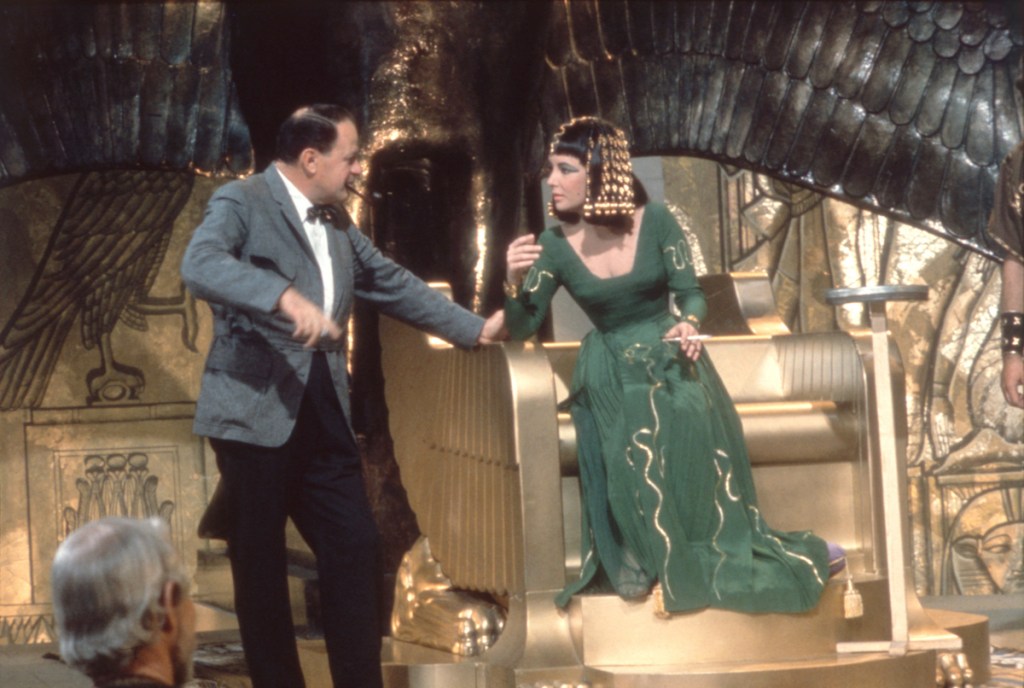
“One of the Worst Decisions of His Life”
The loss of Mamoulian triggered an entire rethinking of Cleopatra from the ground up. While most film studios would’ve shelved the project for good after this amount of failure, studio chief Skouras uncharacteristically decided to gamble big on the film: it would either save or destroy Fox to finish the damn thing.
With co-stars Finch and Boyd also using the mounting chaos to quietly exit stage left, an opportunity arose to completely recast and rebuild the movie around Taylor. So stepped in revered writer-director Joseph L. Mankiewicz, a laureled filmmaker who after having enough zeroes waved in his face by Wanger was convinced to commit to what friend Hume Cronyn described as “one of the worst decisions of his life.”
Mankiewicz, a member of a legendary filmmaker family, is one of those rare storytellers who won back-to-back Oscars for writing and directing with A Letter to Three Wives (1949) and all-time masterpiece, All About Eve (1950). He was also Taylor’s first choice after he directed her in Suddenly, Last Summer (1959). A filmmaker known for his barbed wit and cutting understanding of character psychology, he seemed an odd fit for an epic that would require major battles and spectacle, but his name provided the first good headlines the movie’s flagging production had known.
He also had the opportunity to build his own version of Alexandria and Rome. Describing the mutated Pinewood sets as a “garish nightmare,” Mankiewicz used his clout to get Fox to tear it all down and rebuild Alexandria and Ancient Rome in the actual city of Rome and the historic Cinecittà Studios. He also cast his The Ghost of Mrs. Muir buddy Rex Harrison as Julius Caesar and up-and-comer Welsh thespian Richard Burton as Marc Antony. He even got Fox to pay Broadway producers $250,000 to buy Burton out of his Camelot contract early.
All the while, Joe thought he had enough time to rewrite the Cleopatra script from page one while the sets were being built. It was his first of many mistakes on a film that was costing $70,000 a day in Rome. Before cameras even rolled, the movie’s price tag had now exceeded $18 million, $3 million more than Ben-Hur, the previous most expensive movie ever produced.
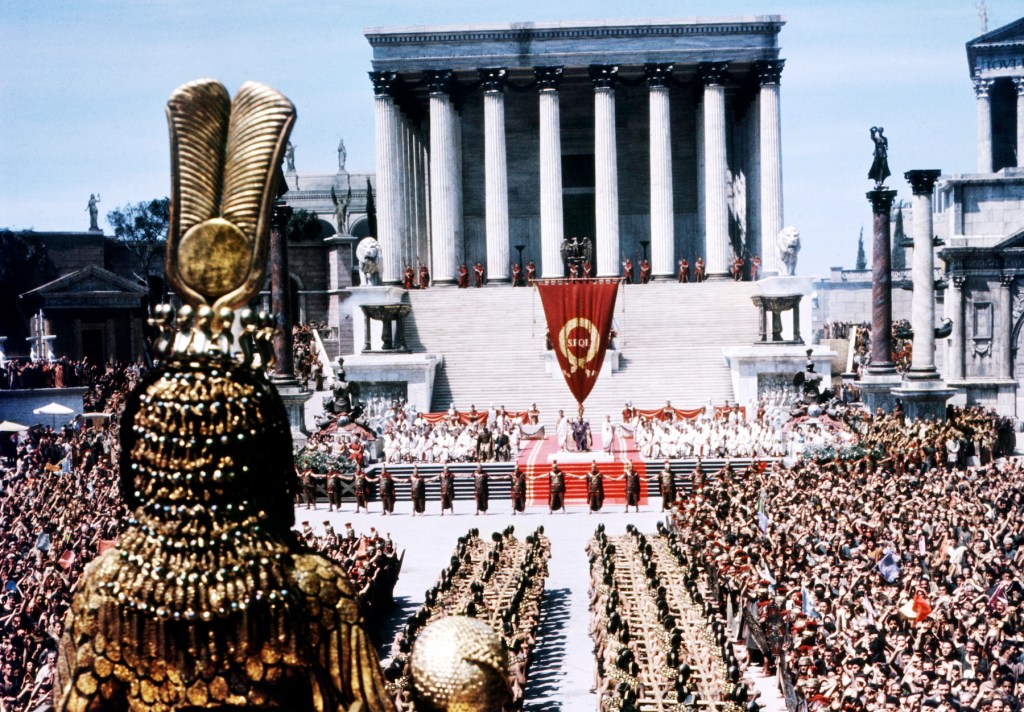
All Roads Lead to…
If you’ve ever sat down and watched Cleopatra—and even if you haven’t—the one scene you remember is when the Queen of Egypt enjoys her triumphant procession through the streets of Rome. Presaged by “Egyptians” on horseback and dancers in the kind of lusty bikinis that only the studio that asked Marilyn Monroe to stand over a grate could engineer, Taylor’s Cleopatra arrives riding a 25-foot tall stone Sphinx.
It’s a great movie moment (with little basis in history), but the fact it took six months to shoot until cinematographer Leon Shamroy got his preferred Roman sunlight sums up the chaos that consumed the production.
In the wind up to filming Cleopatra, Take Two, Mankiewicz began writing the movie from scratch in longhand. He thought he could complete it in a few weeks, even as Fox was spending money on overtime to get the sets finished, but when it came time to roll, the script remained more an elusive concept than a concrete blueprint. As a result, the production would shoot the scenes Mankiewicz wrote the night before (after long days of directing), as opposed to in an order that most efficiently used sets, extras, and weather.
Consequently, most of the actors recalled it as an idle experience. Hume Cronyn, who played Egyptian philosopher Sosigenes, rented a car and spent days touring the Italian coasts and Tuscany. Roddy McDowall, who played a reptilian Octavian (future emperor of Rome), grew so frustrated after relaxing for four months with only one day of work that he begged producer Darryl F. Zanuck for a small role in his D-Day drama shooting in France, The Longest Day (1962). Meanwhile Taylor required an entire building be rented as her dressing room while Harrison threatened to not show up for work if Fox actually fired his chauffeur to cut costs. Through it all, Fox’s best ploy to bring finances down was to ask the crew to reuse their craft paper cups.
And with Mankiewicz creatively pushing Wanger out of any real authority while focusing on his evolving script, there was no one seriously watching costs as the budget ballooned. It reached the point where a few moments of that glorious procession would be filmed one day—complete with a female extra in a bikini so skimpy that she slid off her slick elephant and skinned her exposed flesh—and then the rest of it shot half a year later. But those were the good headlines.
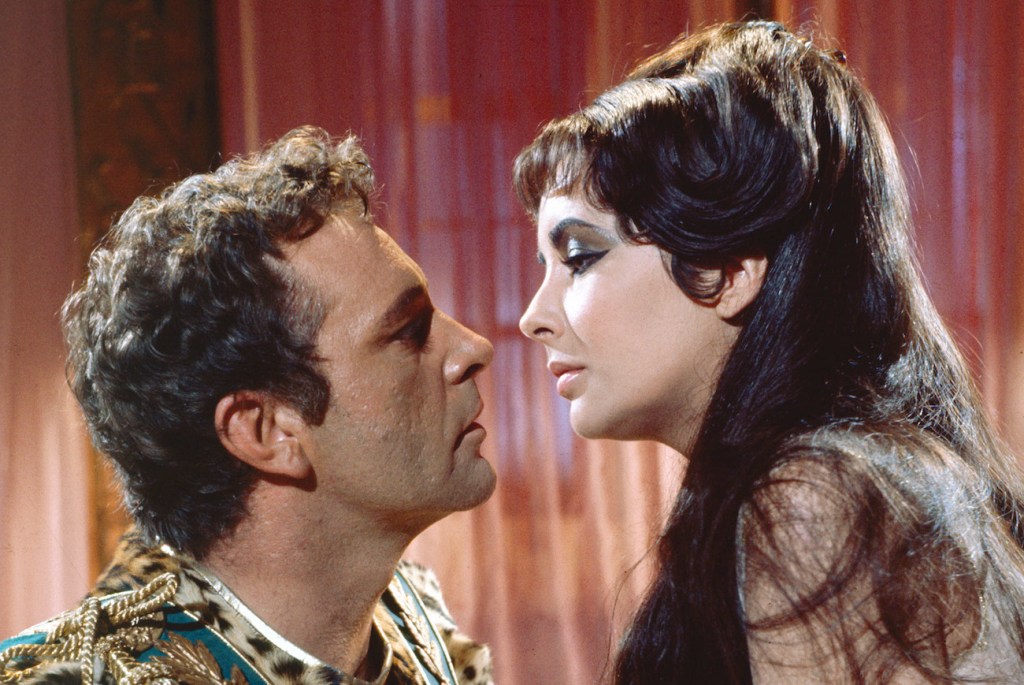
Liz & Dick
At the end of the day, what really made Fox’s folly such an infamous punchline was Antony and Cleopatra. No, not the historic figures or how Shakespeare romanticized them. Rather it was the actors who portrayed them, with Richard Burton lining up to become husband number five (twice).
For months, Taylor and Burton barely shared a moment together, given Joe elected to shoot all of Caesar and Cleopatra’s scenes first. Yet on the first day “Liz and Dick” filmed a scene, biographer Richard Meryman said the two had a meet-cute with Burton coming to set with a characteristically monstrous hangover, and Taylor having to hold his coffee for him while he drank with shaking hands. Sweet, right?
Thus began a very public affair, from kissing in front of co-stars to being photographed on yachting trips to the Italian coast, which may explain why Taylor’s Cleopatra is more tanned in some scenes than others. The fact that they were both married made it scandalous, and that Taylor’s then-husband, Eddie Fisher, learned about it from the paparazzi before surrendering his marriage and fleeing back to New York made it front page news around the world.
The ensuing gossip caused Life magazine to dub Cleopatra “the most talked about movie ever made.” But for Fox it was just one more headache that threatened to drown the movie in bad publicity. After all, the Vatican less charmingly accused Taylor of “erotic vagrancy” and questioned whether she should be forced to give up her adopted children to authorities. The studio would soon fire Wanger from the production.
Ironically, even with this affair turning Cleopatra into the most scandal-plagued production in Hollywood history, very little of that heat appears in the finished film. Taylor’s scenes with Harrison’s Caesar have more energy, if only because Harrison’s Caesar is clearly defined, as are Cleopatra’s motivations for winning his favor. Conversely, Antony is a muddled mess of a character, and Burton’s scenes with the woman he’d marry, divorce, and remarry and divorce again, thud during the picture’s last two hours. Even cold fish Octavian is more compelling.
But then… like everything else, those scenes were born in a midst of chaos…
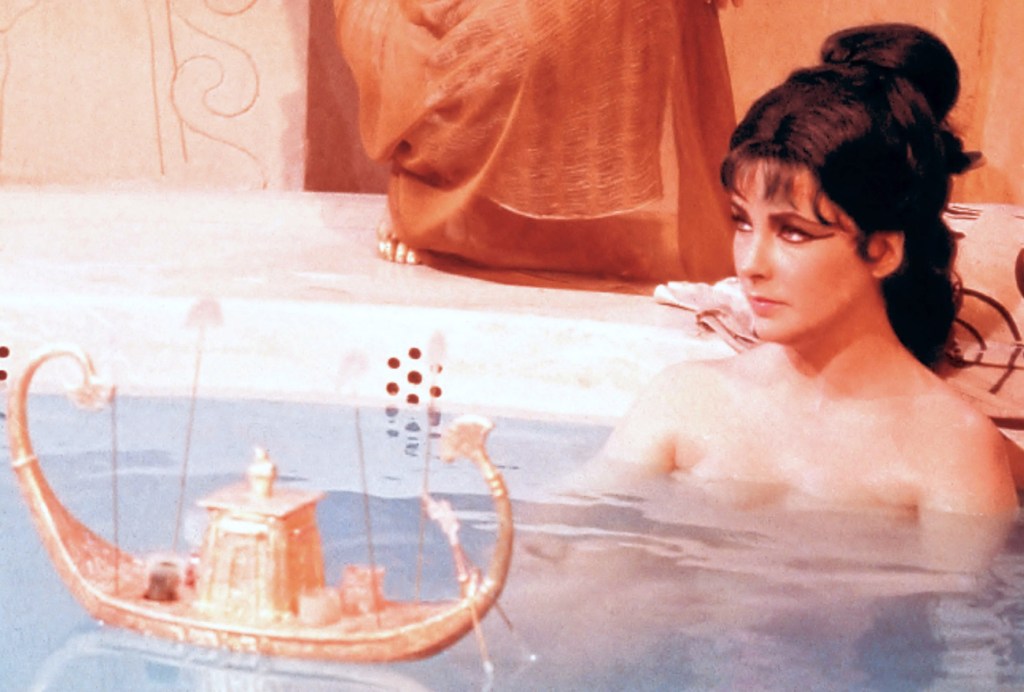
“The Final Humiliation”
It’s been said by more than one director that movies aren’t finished; they’re abandoned. If that’s true, Cleopatra was a case study in being left to die in the streets. The production technically concluded when Mankiewicz, Burton, Harrison, and much of the crew traveled to Egypt to film toothless battle sequences in the real deserts. But then they had to come home.
By the time filming wrapped on the movie in 1962—nearly two years after sets in London were built—Fox was no longer the same studio. The company had already begun cutting costs and reducing production to offset the expenditure on their would-be epic. Marilyn Monroe’s Something’s Got to Give, for one, was abandoned days before shooting. Some even attribute Monroe’s suicide to that cancellation. But the studio’s biggest mistake may have been trying to reduce the cost (and denying an extra $2 million) to The Longest Day.
A World War II passion project for Darryl F. Zanuck, The Longest Day was the type of movie Zanuck retired from running Fox to make. But upon learning the studio he co-founded in 1935 was on the verge of bankruptcy over Cleopatra, he staged a coup to stop what he saw as bleeding in the Italian and Egyptian sun. At a quarterly report for the studio’s board of directors, Zanuck pushed Skouras out and returned to Fox as president. He even made his son Richard D. Zanuck head of production: his first priority was to halt all other productions. Nothing was shooting on the Fox lot while Zanuck the Elder attempted to survey the damage left in Cleopatra’s wake.
His first battle with Mankiewicz came over the director’s idea to cut his footage into two movies. Convinced he’d written and filmed too much to squeeze into a single running time, the succinct storyteller behind All About Eve now wanted three hours for Caesar and Cleopatra (named after the George Bernard Shaw play) and another three hours for Antony and Cleopatra (Shakespeare). But Zanuck had a plausible fear about such a gamble: If Taylor and Burton don’t have any scenes in the first film they released in 1963, who’s to say the couple would still be together in ’64 when volume two launched?
So Mankiewicz was required to cut the film into four hours—which he did only after Zanuck publicly fired him and was then forced to rehire him because the studio mogul couldn’t make sense of a story out of the footage. There was also the problem of Mankiewicz’s battle scenes lacking the vigor of Cecil B. DeMille’s M.O. or William Wyler’s Ben-Hur… so then came the reshoots.
Cleopatra eventually premiered in New York on June 12, 1963. The finished film came at a running time of four hours and 11 minutes. Liz Taylor missed that premiere but after being forced to go to its London debut, she concluded, “The final humiliation was finally having to go see it.” She’d elaborate later in life that “they had cut out the heart, the essence, the motivations, the very core… It should have been about three large people, but it lacked reality and passion. I found it vulgar.”
And after its roadshow tour around the U.S., Zanuck found it still too long and forced Joe to cut it down by another hour to a final running time of three hours and 18 minutes. While the effect produced relative success—with the movie grossing $57.8 million over the next five years—to say it left its studio disappointed is an understatement. Sure, it didn’t sink Fox, but the studio remained on the verge of collapse until The Sound of Music two years later. The studio became so indifferent they even screwed Roddy McDowell out of an Oscar nomination by submitting the film’s best performance in the leading actor category instead of Best Supporting Actor.
To his dying day, Mankiewicz fought to get the six-hour cut restored, but the missing footage appears to be lost to time, although the four-hour roadshow is now available for home video. I wouldn’t recommend it.

